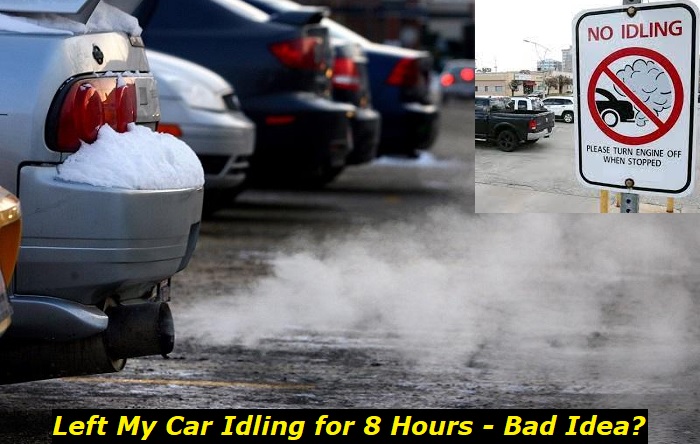Why one would leave the engine idling for eight hours is beyond us. However, there are times when this indeed happens such as when you are stuck in an extreme traffic jam, you need to pull to the side of the road to rest, forgetfulness, negligence, or other situations.
Engine idling problems highlights
- Level of urgency:Low
- DIY inspection:Possible but may be complicated
- DIY repair:Sometimes, possible
- Cost of repair:$150 - $600
- Can you drive?Yes
- Commonreasons:IAC valve, throttle position sensor, MAF sensor, carb problems, fuel pressure issues, air supply problems
- Ways to fix:Adjusting the system or replacing the faulty sensor or another part thatis diagnosedto be bad

Things that Commonly Go Bad with 8 Hours of Idling
We all know that extended idling, especially one that goes up to eight hours, can certainly spell bad news for the environment and one's health. On the side of the engine though, these are the major consequences that you will most likely encounter:
1. Quick Fuel Drain and More Emissions
When a vehicle is idling for an extended period, it can cause fuel to drain quickly. This is because the engine does not reach its optimal temperature in this condition, which leads to incomplete burning of fuel and increased exhaust emissions. In addition, when the engine remains in idle longer than necessary, fuel continues to flow into the cylinders without the vehicle actually moving forward. This results in more fuel going to waste and ultimately being released into the atmosphere.
A common misconception that many people have is that leaving a car in idle mode saves money on fuel costs since the vehicle is not moving. However, this could be further from the truth as leaving an engine in idle mode causes inefficient use of fuel. Furthermore, if the engine is left in idle mode for too long, it can lead to engine wear and tear due to the increase in carbon deposits.
The best practice to prevent this is to turn off the car when you know you will be sitting in one place for more than a few minutes. This will help reduce emissions and save money on fuel costs.
2. More Oil Burn
When a vehicle is idling for an extended time, the engine can start to build up oil deposits which can cause more fuel to be burned. This is because when an engine is running over long periods without being used, the oil remains in the same place and it starts to thicken as it accumulates more particles from the combustion process.
As this happens, the oil flow becomes obstructed and causes higher friction between moving parts in the engine. The increased friction creates more heat which requires more fuel to be burned for the engine to keep running.
Likewise, with less efficient oil flow due to blockage, there's an increase in wear and tear on certain parts of the vehicle such as valves, pistons, or even bearings. This can cause the engine to become less efficient over time and require more fuel to keep running.
Lastly, idling for a long time can cause engine failure due to the extra stress placed on it by the increased friction and heat. So, it is important to avoid idling an engine like this as much as possible.
3. Head Gasket Damage
One of the first to go in the engine with this length of idling is the head gasket. The head gasket is responsible for sealing the combustion chamber in the engine and providing a consistent flow of coolant throughout.
The common symptoms associated with a head gasket issue can vary depending on the extent of the damage. However, if you find yourself experiencing coolant leaking from the engine, white smoke from the exhaust, frothy oil in the radiator, overheating, and compression loss in one or more cylinders after extended idling, then you might be facing this problem.
To confirm if the signs truly point to a faulty head gasket, there are several steps that need to be taken. These include inspecting all visible parts of the engine and running tests using diagnostic tools like pressure testers or cylinder leakage detectors.
Once it has been determined that a head gasket failure is responsible for the problem, repairs must be done to rectify the issue. This process involves the replacement of the head gasket, as well as some other parts that may have been damaged due to the prolonged period of idling.
These may include the cylinder head and/or any associated seals or gaskets. In addition, it is always recommended to flush out the cooling system and replace the coolant with a new mixture to help prevent further damage.
4. Worn Spark Plugs
The spark plug is another part that will usually fail during extended idling, especially if the duration is within eight long hours. The spark plug plays an important role in the ignition system and is responsible for igniting the fuel-air mixture in your engine. The common symptoms of a worn spark plug are rough idling, misfires, and engine hesitation. So, better watch out for these after this incident.
To confirm the problem if you are experiencing any of the signs, you need to do a physical inspection with the existing spark plugs in your engine. Check if there is any hint of wear or damage on its surface such as erosion or blistering. You can further test it using an ohmmeter to measure the electrical resistance between the contact points of the spark plug. The reading should match with OEM specifications found in your vehicle's service manual. Otherwise, that means there is something wrong with it and needs replacement.
The solution for this problem is to replace your spark plug with a new one that matches OEM specifications. Make sure that you also change other parts like the spark plug wires, distributor cap, and rotor if they have been affected by the problem. It is also recommended to replace the air and fuel filters as they are also prone to damage during long hours of idling. With this, you can be sure that your engine can run properly and efficiently.
The replacement of the spark plugs can be easily done with the right tools and a basic understanding of the inner workings of the engine, but if you encounter any difficulty in replacing these parts, it would be best to contact a qualified mechanic or technician for help.
5. Cylinder Ring Failure
Idling for extended periods can cause significant damage to the cylinder ring. The cylinder ring plays an important role in the engine because it helps maintain the right amount of pressure needed to keep combustion going.
The most common symptom of this type of damage is excessive oil consumption, misfiring, and increased emissions. If left untreated, this problem can also lead to a loss in engine power or complete engine failure over time.
To check that the issue lies with the cylinder rings, visually examine for cracks or signs of wear on the surface and use compression testing tools to look for air leaks from each cylinder. It is important to note that these tests must be done while the engine is cold to get an accurate reading.
The repair solution will depend on how much damage has been caused by the extended idling period. Generally speaking, if only minor wear has occurred and your cylinder rings are still relatively new, they can be honed and reused. If there is significant wear or damage on this component, then the cylinder rings will need to be replaced along with other affected parts such as pistons and piston rings.
6. Engine Shutdown Due to Power Drain
If your car's engine is idling for more than 8 hours, it can lead to a complete shutdown caused by a major battery power drain. There are several common symptoms of extensive battery drain in a vehicle.
As the power level drops, you may notice the headlights and other electrical devices like radio, air conditioning systems, and interior lighting, dimming or flickering intermittently. Your engine can become harder to start due to low charge levels and, in some cases, may even fail to start at all.
To evaluate the cause of this problem, one should perform an initial visual check-up on the battery itself for any signs of major wear or shorting. Tools such as multimeters can be utilized to measure whether the battery can still hold a charge or is in need of replacement, too.
A reading that indicates that the battery can still be saved through recharging is around 12.4 volts, and anything lower than such a reading implies that the battery has been completely drained and requires replacement. Furthermore, if the above-mentioned symptoms persist after the battery has been recharged, then it may be time to replace other affected parts such as the parts of the alternator.
If the battery is found to be the root cause, then it needs to be replaced for your car to start functioning again. This can involve replacing the battery itself or even larger components such as alternators or starters if they are also affected by low power levels.
Other parts like wiring and fuses may also need attention since they play an important role in charging and powering these devices. It is advisable to have a professional mechanic inspect other potential causes as well before any permanent solution is applied.
Conclusion
The things shown to you here are only the most common scenarios that can take place in your engine after idling for eight hours or if you regularly subject your vehicle to extended idling. With the consequences that these factors can potentially bring, which will surely put a dent in your budget, this kind of abuse to your engine should be avoided entirely.
About the authors
The CarAraC research team is composed of seasoned auto mechanics and automotive industry professionals, including individuals with advanced degrees and certifications in their field. Our team members boast prestigious credentials, reflecting their extensive knowledge and skills. These qualifications include: IMI: Institute of the Motor Industry, ASE-Certified Master Automobile Technicians; Coventry University, Graduate of MA in Automotive Journalism; Politecnico di Torino, Italy, MS Automotive Engineering; Ss. Cyril and Methodius University in Skopje, Mechanical University in Skopje; TOC Automotive College; DHA Suffa University, Department of Mechanical Engineering






Add comment